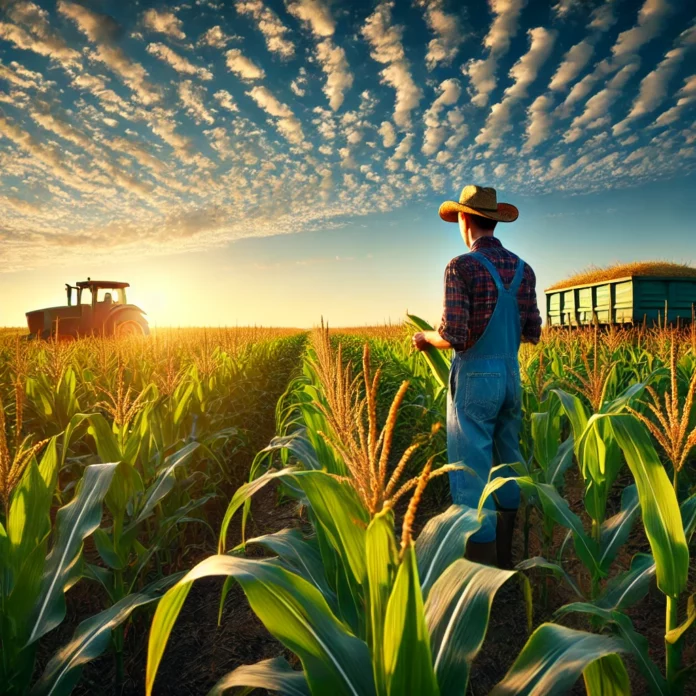Corn, also known as maize, is one of the most widely cultivated and consumed crops globally. As a staple food, animal feed, and raw material for various industries, corn plays a pivotal role in ensuring global food security. In this article, we explore the world’s largest corn producers, their contributions to the global market, and the key trends shaping the corn industry.
Top Corn Producers in the World
- United States
- Production Volume: The U.S. is the largest producer of corn, accounting for approximately 32% of the world’s total production. In 2023, the U.S. produced over 360 million metric tons of corn.
- Major Growing Regions: The Corn Belt, which includes states like Iowa, Illinois, Nebraska, and Minnesota, is the heart of U.S. corn production.
- Uses: The majority of U.S. corn is used for animal feed, ethanol production, and exports.
- China
- Production Volume: China is the second-largest corn producer, with an annual output exceeding 275 million metric tons.
- Major Growing Regions: Heilongjiang, Jilin, and Inner Mongolia are key areas for corn cultivation.
- Uses: Corn in China is primarily used for domestic consumption as animal feed and for industrial purposes.
- Brazil
- Production Volume: Brazil is a growing powerhouse in corn production, yielding over 120 million metric tons annually.
- Major Growing Regions: Mato Grosso, Paraná, and Goiás are major corn-producing states.
- Export Leadership: Brazil is one of the leading exporters of corn, with much of its production destined for global markets.
- Argentina
- Production Volume: Argentina produces approximately 60 million metric tons of corn annually.
- Major Growing Regions: Buenos Aires, Cordoba, and Santa Fe lead in corn cultivation.
- Global Role: As a top exporter, Argentina contributes significantly to international corn trade.
- India
- Production Volume: India produces around 30 million metric tons of corn annually.
- Major Growing Regions: Karnataka, Andhra Pradesh, and Maharashtra are key production areas.
- Uses: Corn is primarily used for food, feed, and industrial purposes in India.
- Ukraine
- Production Volume: Ukraine produces over 35 million metric tons of corn, despite challenges posed by geopolitical tensions.
- Major Growing Regions: Central and southern Ukraine are key areas of cultivation.
- Exports: Ukraine is a significant exporter of corn to European and Asian markets.
- Mexico
- Production Volume: Mexico produces roughly 27 million metric tons of corn annually.
- Major Growing Regions: Sinaloa, Jalisco, and Michoacán are the top contributors.
- Historical Importance: As the birthplace of maize, Mexico’s corn production has deep cultural and agricultural significance.
Key Trends in Global Corn Production
- Climate Change Impact: Erratic weather patterns are affecting yields in major growing regions, prompting the adoption of drought-resistant corn varieties.
- Technological Advancements: Precision agriculture and genetically modified (GM) seeds are improving productivity and resilience against pests and diseases.
- Rising Demand for Biofuels: With the push for cleaner energy, corn-based ethanol production is increasing, particularly in the U.S. and Brazil.
- Export Dynamics: Countries like Brazil, Argentina, and Ukraine are strengthening their positions as leading exporters, driven by growing demand in Asia and Africa.
Challenges Facing the Corn Industry
- Geopolitical Tensions: Conflicts, such as those affecting Ukraine, disrupt global supply chains.
- Sustainability Concerns: Large-scale corn production raises issues related to soil health, water usage, and pesticide application.
- Market Volatility: Fluctuations in prices due to weather conditions, trade policies, and currency changes impact global trade.
Conclusion
The global corn industry remains dynamic, driven by the interplay of domestic production, international trade, and evolving market demands. The United States, China, and Brazil lead the charge, shaping the future of this essential crop. However, challenges like climate change and geopolitical instability underscore the need for sustainable practices and innovative solutions to secure corn’s role in feeding the world.



